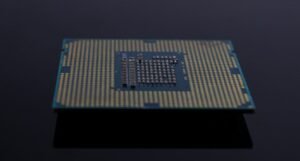Film Grain: Ready or Not
In the digital age of photography and cinematography, film grain has become a popular tool to recreate the nostalgic look of analog film. Film grain refers to the random, visible particles that appear in images captured on film. While some photographers and filmmakers prefer the clean and sharp look of digital imagery, others embrace the aesthetic qualities and textures that film grain adds to their work. Whether you are ready to embrace the grain or not, understanding its characteristics and creative applications can be valuable in your artistic journey.
Key Takeaways
- Film grain is the random particles that appear in images captured on film
- Some photographers and filmmakers prefer the nostalgic and aesthetic qualities of film grain
- Film grain can add texture and depth to digital images
- Understanding the characteristics and creative applications of film grain is valuable for artists
*Film grain* is a visual characteristic that has been a part of photography and filmmaking since the early days of analog film. It is caused by the random clumping of silver halide crystals in the emulsion coating of the film, resulting in a fine texture or grain visible in the final image. Film grain adds a unique quality to the image, especially noticeable in lower light conditions or when using higher film speeds.
Why Embrace Film Grain?
While digital photography and cinematography offer unparalleled sharpness and clarity, many artists and professionals still prefer the nostalgic and aesthetic qualities that film grain provides. The organic nature of film grain adds texture and depth to images, enhancing the artistic expression of the photographer or filmmaker. It can evoke a sense of nostalgia, reminiscent of the film’s golden age and the unique characteristics of different types of film stock.
In addition to its aesthetic value, film grain can also be used strategically to enhance storytelling. It can create a sense of authenticity and realism, particularly in period pieces or movies aiming for a vintage look. The presence of film grain can subtly transport the audience to a different era or evoke a specific mood.
Understanding Film Grain Characteristics
Before diving into the creative applications of film grain, it’s important to understand its characteristics. Here are some key points to consider:
- Grain Size: Film grain is available in various sizes, from fine to coarse. Finer grain is often associated with professional film stocks, while larger grain can create a more dramatic and gritty effect.
- Grain Structure: The appearance of film grain can differ depending on the film stock used. Different film stocks have distinct grain structures, which can contribute to the overall aesthetic of the image.
- Grain Pattern: Film grain patterns vary, with some films exhibiting a more uniform pattern and others featuring a more random distribution. The grain pattern can influence the overall feel and style of the image.
Harnessing Film Grain Creatively
Now that you have a grasp on the characteristics of film grain, let’s explore some creative ways to use it:
- Recreating Vintage Look: Film grain can effectively recreate the look of different historical periods, adding authenticity to your work. Experimenting with various film stocks and grain sizes can help achieve the desired effect.
- Enhancing Mood: Utilize film grain to enhance the mood of your images or videos. The unique texture and subtle imperfections can contribute to a specific atmosphere, such as a dreamy or moody setting.
- Adding Depth and Texture: Film grain can add a layer of depth and texture to flat digital images, creating a more visually interesting composition. It can enrich details and provide a tactile quality to the visual elements.
Film Grain: Good to Know
Before incorporating film grain into your workflow, here are some additional points to consider:
| Pros | Cons |
|---|---|
| + Enhances nostalgic and aesthetic qualities | – May not suit all genres or styles |
| + Adds depth and texture to images | – Can introduce visual noise or distraction |
| + Contributes to a vintage or period look | – Requires careful balancing in post-processing |
| + Evokes emotions and enhances storytelling | – Can affect overall image sharpness |
It’s important to evaluate whether incorporating film grain aligns with your artistic vision, genre, and desired outcome. Experimentation and finding the right balance in post-processing are key to achieving the desired effect without compromising the overall image quality.
*Film grain* remains a powerful tool for photographers and filmmakers seeking to capture a specific aesthetic or evoke a particular mood. Understanding its characteristics, creative applications, and potential limitations allows artists to explore new avenues for visual storytelling and express their unique vision. So, whether you are ready to embrace the grain or not, film grain can undoubtedly add a touch of nostalgia and artistic flair to your work.

Common Misconceptions
Paragraph 1
One common misconception about film grain is that it is a flaw or a sign of poor quality in films. Many people believe that a film with grainy visuals is inferior to one with pristine, clear images. However, film grain is actually a deliberate aesthetic choice made by filmmakers to evoke a certain mood or enhance the storytelling.
- Film grain can add a sense of nostalgia and authenticity to a film.
- Grainy visuals can create a more immersive and atmospheric experience for the audience.
- Some renowned directors intentionally incorporate film grain to achieve a desired artistic effect.
Paragraph 2
Another misconception people have about film grain is that it is an outdated technique only used in older movies. While it is true that film grain was more prominent in the past due to the limitations of film stock, it is still used extensively today. Many modern films deliberately add film grain in post-production to achieve a specific aesthetic, even in movies shot on digital formats.
- Film grain is not restricted to a specific era of filmmaking and can be utilized by contemporary directors.
- Even digital filmmakers simulate film grain to replicate the vintage look or emulate a specific time period.
- Film grain can be added in post-production using various software and plugins.
Paragraph 3
Some people assume that film grain is synonymous with noise and degradation of image quality. They believe that a film with grain will always be less sharp and detailed compared to a film without it. However, film grain itself does not necessarily imply a loss in image quality. It can coexist with sharpness and high definition visuals depending on the filmmaking process and the creative intent.
- The presence of film grain does not necessarily indicate a drop in image clarity or sharpness.
- Film grain can be controlled and adjusted to balance artistic choices while maintaining image quality.
- High-quality film stocks and digital techniques allow directors to have greater control over the appearance of grain in their films.
Paragraph 4
There is a misconception that film grain is an unnecessary distraction that takes away from the overall viewing experience. Some individuals argue that a film should always strive for a clean and clear image without any visual interference. However, film grain can add texture and character to the visuals, immersing the audience in the atmosphere of the film and enhancing the storytelling.
- Film grain can contribute to the visual storytelling by adding depth and texture to the images.
- It can create a unique visual style that complements the narrative and enhances emotional impact.
- Film grain is appreciated by many cinephiles and film enthusiasts for its artistic value.
Paragraph 5
A common misconception is that film grain is only associated with dramatic or serious films. Many people believe that only certain genres, such as film noir or period dramas, benefit from the addition of grainy visuals. However, film grain can be used in a wide variety of genres and styles, from comedy to sci-fi, to evoke different moods and enhance the overall cinematic experience.
- Film grain can be used in comedies to create a nostalgic or retro atmosphere.
- In sci-fi films, film grain can give a sense of grittiness and a raw, lived-in futuristic world.
- Even animated films, both traditional and CGI, utilize film grain to add an organic and handcrafted feel.

Film Grain Sizes and Characteristics
Film grain refers to the textured appearance of film images due to the chemical composition and size of the crystals that capture light. Different film stocks have varying grain sizes, which can result in distinct visual effects. This table showcases the characteristics and common uses of various film grain sizes.
| Grain Size | Characteristics | Common Uses |
|---|---|---|
| Super Grain | Extremely fine particles, almost imperceptible | High-resolution photography, detailed stills |
| Fine Grain | Small, fine particles | General-purpose film, ideal for portraits |
| Medium Grain | Visible but not overpowering grain | Documentary work, capturing texture |
| Coarse Grain | Larger, prominent grains | Experimental filmmaking, augmenting atmosphere |
Film Grain Comparison: Digital vs. Analog
As digital photography and cinematography have become more prevalent, the debate between the aesthetics of digital images and the charm of analog film grain has intensified. This table compares the characteristics of film grain and digital noise.
| Aspect | Film Grain | Digital Noise |
|---|---|---|
| Origin | Naturally occurring during film development | Generated by electronic sensors |
| Pattern | Uniform and organic | Inconsistent and random |
| Aesthetic | Can add character and nostalgia | Often perceived as technical flaws |
| Manipulation | Different grain sizes can be chosen | Can be reduced or amplified in post-processing |
Iconic Films Known for Unique Grain Patterns
Some films have gained notoriety for their distinctive grain patterns, which became an integral part of their visual identity. This table highlights a few celebrated films and their associated grain characteristics.
| Film | Grain Characteristic | Significance |
|---|---|---|
| Blade Runner | Heavy, dark, and shadowy grain | Enhances the neo-noir atmosphere |
| 2001: A Space Odyssey | Fine, smooth, and almost non-existent grain | Creates a sense of pristine futurism |
| The Godfather | Medium grain with warm tones | Evokes a nostalgic and timeless feel |
| Nyarlathotep | Intentionally distorted and erratic grain | Reflects the film’s chaotic and surreal narrative |
Film Grain Simulation in Digital Post-Processing
In the digital era, post-processing techniques have been developed to simulate the organic look of film grain. This table explores different methods and tools used to achieve film grain simulation.
| Method | Description | Advantages |
|---|---|---|
| Noise Overlay | Applying layers of digital noise with varying opacities | Flexible control over grain intensity and size |
| Grain Plugins | Specialized software plugins that add grain effects | Offers customizable grain options and presets |
| Texture Mapping | Mapping film grain textures onto digital footage | Produces realistic and natural-looking grain patterns |
| Scanned Film Grain | Digital overlay of grain patterns from real film scans | Authentic replication of various film stocks |
The Role of Film Grain in Genre Films
In different film genres, the intentional use of specific film grain characteristics can enhance the storytelling and visual style. This table explores how film grain is used in various genres.
| Genre | Grain Characteristics | Effect on Atmosphere |
|---|---|---|
| Horror | Coarse, uneven grain with high contrast | Creates an unsettling and raw atmosphere |
| Film Noir | Heavy, dark, and pronounced grain | Enhances the gritty and mysterious tone |
| Science Fiction | Minimal or ultra-fine grain | Elevates the futuristic and clean aesthetic |
| Period Drama | Medium grain with warm and muted tones | Elicits a sense of nostalgia and timelessness |
Film Grain Impact on Viewer Perception
The presence or absence of film grain can influence the way viewers perceive and emotionally connect with a film. This table illustrates the potential impact of film grain on viewer perception.
| Grain Intensity | Viewer Perception |
|---|---|
| No Grain | Perceived as polished, sharp, and modern |
| Subtle Grain | Creates a sense of familiarity and authenticity |
| Pronounced Grain | Evokes nostalgia, adds texture, and enhances mood |
| Excessive Grain | Can be distracting and hinder visual clarity |
Changing Film Grain Preferences in Filmmaking
Over time, the preference for different film grain sizes has evolved, reflecting changing trends and artistic choices. This table explores the historical preferences in the filmmaking industry.
| Decades | Popular Grain Preferences |
|---|---|
| 1950s | Medium to coarse grain for dramatic effect |
| 1960s-1970s | Preference for larger grain sizes to emphasize realism |
| 1980s-1990s | Fine grain, aiming for a more polished look |
| 2000s-Present | Varied preferences, embracing both digital and film aesthetics |
Film Grain’s Enduring Appeal to Filmmakers
Despite advancements in digital technology, the charm and unique character of film grain continue to attract filmmakers. This table explores the reasons why many directors and cinematographers choose to incorporate film grain into their work.
| Reason | Description |
|---|---|
| Nostalgic Aesthetics | Evoke a sense of classic cinema and vintage feel |
| Enhanced Atmosphere | Add texture, mood, and visual interest to the image |
| Authenticity & Artistic Expression | Embrace imperfections and celebrate the analog process |
| Visual Differentiation | Create a distinct look and stand out from the digital crowd |
Conclusion
Film grain remains an integral part of the artistic expression and visual storytelling in cinema. Whether it’s the subtle touch of nostalgia, the enhancement of atmosphere, or the embrace of imperfections, film grain continues to captivate both filmmakers and audiences. As technology progresses, the choice between digital precision and the organic allure of film grain becomes a creative decision that contributes to the unique language of each filmmaker. By understanding and utilizing the characteristics of film grain, creators can craft visuals that evoke emotions, transport viewers, and immerse them in captivating cinematic experiences.
Frequently Asked Questions
What is film grain?
Film grain refers to the texture or appearance of fine particles that are visible in analog photographic film or digital media. It is caused by the random distribution of silver halide crystals in film or electronic noise in digital sensors.
Why is film grain desirable in movies?
Film grain is often considered desirable in movies as it can add a nostalgic or artistic look to the footage. It can enhance the visual quality and create a more immersive viewing experience.
Can film grain be added to digital videos?
Yes, film grain can be added to digital videos during post-production using various editing software. This allows filmmakers to recreate the vintage aesthetic of traditional film or achieve a specific artistic effect.
Is film grain always present in analog film?
Yes, film grain is a natural characteristic of analog film. It is an inherent property that cannot be entirely eliminated, although the grain size and visibility can vary based on the film stock and the specific development process.
What factors influence the visibility of film grain?
The visibility of film grain can be influenced by several factors, including the film stock’s ISO sensitivity, the lighting conditions during filming, the exposure settings, the type of camera used, and the quality of film development.
Does film grain affect image quality?
Film grain does not necessarily diminish the image quality of a film or video. In fact, many filmmakers intentionally utilize film grain to enhance the artistic value and overall appearance of their work. However, excessive grain can sometimes result in a loss of detail and increase the apparent noise in the footage.
Are there any disadvantages to film grain?
While film grain is often appreciated for its aesthetic qualities, it may not be suitable for all types of videos or desired visual styles. Some viewers might perceive excessive grain as a distraction, and it can also impact image sharpness, especially in low-light or high-ISO situations.
Can film grain be removed or reduced in post-production?
Yes, film grain can be reduced or removed during post-production using various software tools or plugins. However, it requires expertise and careful adjustment to avoid affecting the overall visual integrity and desired look of the footage.
Are there any alternatives to film grain in digital videos?
Yes, there are alternative techniques to achieve a film-like aesthetic in digital videos. These include color grading, adding digital filters or overlays, adjusting sharpness and contrast, and using specialized plugins or software to simulate the appearance of film.
Is film grain a subjective choice in filmmaking?
Yes, the use of film grain is subjective and depends on the director’s artistic intent and the overall tone of the film. Some filmmakers prefer a clean and polished look, while others embrace film grain as an essential element of their storytelling or visual style.




